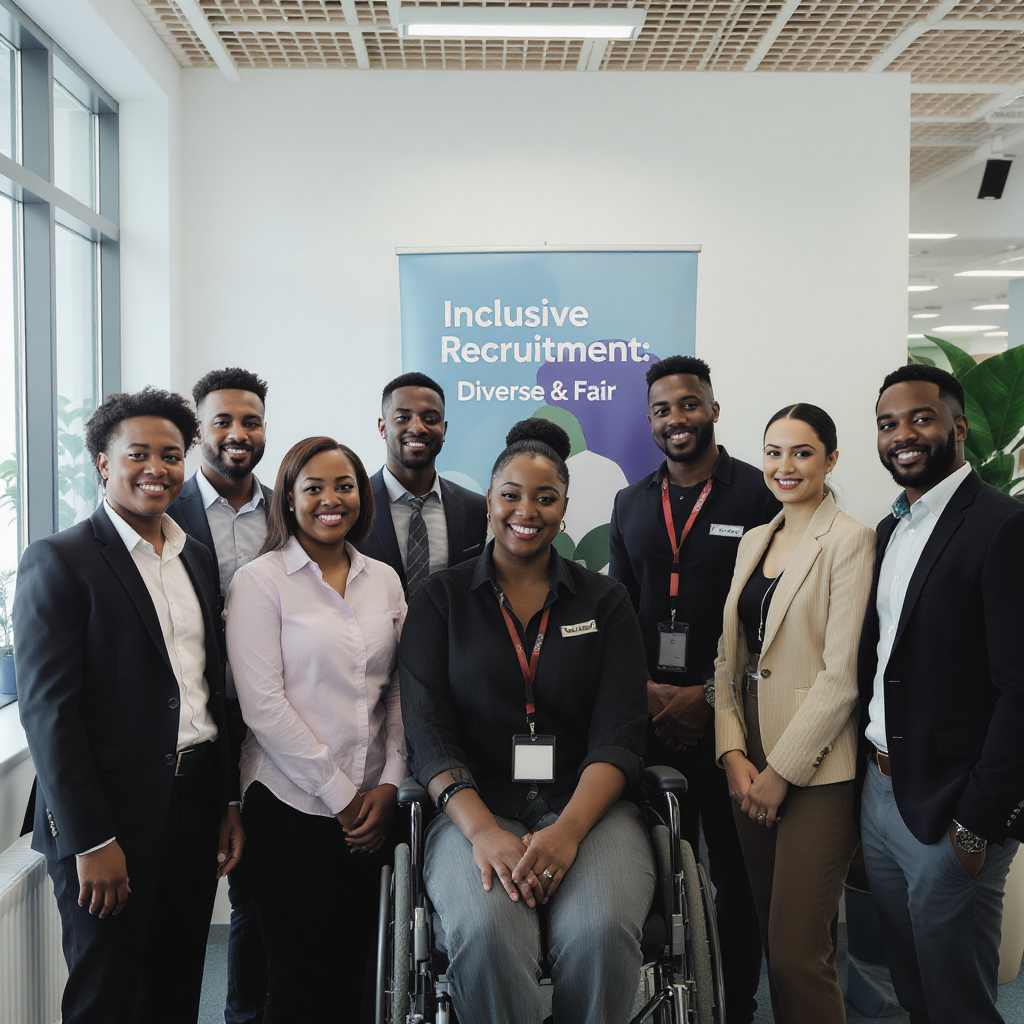Find out how to make your recruitment more inclusive by eliminating bias and adopting fair practices that value diversity and fluency in English.
Imagine two CVs. Both have strong experience, aligned technical skills, and consistent career paths. However, during the interview, one candidate speaks confidently but with a non-standard accent. The other stumbles over English grammar but demonstrates deep understanding of the subject. Who gets the job?
The answer says more about your selection process than about the candidates.
The answer reveals more about your recruitment process than the candidates themselves.
Inclusive recruitment requires more than good intentions. It demands intentionality, revised criteria, awareness of bias, and a willingness to challenge the traditional “ideal profile.”
This article helps you audit your process, identify exclusion filters, and adopt strategies—like using FluencyFlow—to build fairer, more diverse, and more strategic recruitment practices.
What does inclusive recruitment mean?
Inclusive Recruitment is not about filling quotas, nor is it about hiring “those who think differently just for the sake of thinking differently.” It’s about structuring processes that don’t exclude talent for reasons unrelated to competence.
In practice, this means examining every stage of Recruitment, from the job description to the final interview, and asking: Who is being left out here? Why?
Often, the filter is not in the qualifications required, but in the way, we assess those qualifications. Fluent English, for example, is often a barrier.
But are we assessing fluency fairly? Or are we discarding excellent professionals because they speak with an accent, hesitate when thinking, or don’t use the expressions we are used to hearing?
Recruiting inclusively requires HR to question the traditional selection model, review its criteria honestly, and adopt practices that guarantee real access to opportunities, not just the appearance of diversity.
It’s about putting real competencies at the center and leaving aside impressions that mask the potential of those on the other side of the table.
Inclusion, in this context, is not a favor; it is a fundamental principle. It’s what happens when the process is done well.
Benefits for the company and the team
Inclusive Recruitment is not about “making exceptions.” It’s about removing barriers that should never have existed. When the process is fairer, everyone wins: those who hire, those who join, and those who are already on the team.
Companies that bet on inclusion see real gains on several fronts:
- More innovation and creativity, with teams made up of different backgrounds and repertoires
- Richer decision-making, with multiple points of view on the table
- Reduced turnover, as professionals who feel welcome stay longer
- Access to talent outside the “standard profiles,” which increases the competitiveness of the business
- Strengthening of the employer brand, which becomes associated with purpose and respect
Inclusive environments also tend to be healthier and more collaborative, which improves the climate, performance, and, ultimately, results.
Common barriers and how to overcome them
Even with the best of intentions, inclusion doesn’t happen by chance. Many companies encounter structural and cultural barriers that continue to restrict access to specific profiles, particularly when the selection process involves interviews conducted in English or candidates from diverse socio-cultural backgrounds.
One of the most recurrent obstacles is linguistic bias. Candidates are discarded not because they lack technical knowledge but because they speak with an accent, hesitate in their speech, or fail to meet the “expected” standard of communication.
This is particularly evident in English interviews, where fluency is often assessed based on stage performance rather than functional competence.
Another silent barrier is the recruiter’s mental model, which often, without realizing it, favors profiles similar to one’s own or repeats requirements that exclude more than they filter, such as the famous “fluent English,” without considering that fluency can be developed for the job.
To overcome these blockages, HR needs to regularly review the criteria, adopt a critical attitude towards the filters themselves, and invest in tools that bring more objectivity to the process.
This is how the intention to include becomes fair practice.
Inclusive language in job advertisements
A truly inclusive recruitment process starts long before the interview. It begins with the way the vacancy is written.
The language used may seem neutral at first glance. Still, it often carries an implicit bias that deters good candidates from the start of the funnel.
Expressions such as “ninja,” “aggressive,” “blood in the eyes,” or “recent graduate” can suggest an environment that is competitive, exclusionary, or targeted at a specific demographic, typically young males from a particular social background.
This limits diversity, meaning that qualified professionals often feel they don’t belong.
To attract different profiles and make the process fairer from the outset, advertisements should:
- Avoid terms with connotations of gender, age, or stereotypes
- Make the company’s commitment to diversity and inclusion clear and transparent.
- Focus on the skills that are genuinely needed rather than generic requirements.
- Offer accessibility with variations such as audio descriptions or adapted formats.
A well-written job description doesn’t filter by affinity, and it invites by potential. And that makes all the difference to the type of talent you can attract.
How to avoid unconscious bias
Unconscious biases are mental shortcuts we use to make quick decisions, often without realizing it.
In the context of Recruitment, these shortcuts can become invisible filters that eliminate candidates based on stereotypes, personal preferences, or preconceived ideas rather than on real competencies.
Avoiding this kind of bias requires intention and a structured approach. HR needs to define objective criteria and standardize selection processes, ensuring that all candidates are assessed under the same conditions.
This includes using consistent interview scripts, promoting awareness training with recruiters, and prioritizing evaluations based on practical performance rather than just impressions.
Tools like FluencyFlow are especially useful in this scenario. The platform assesses English fluency in a technical and automated way without being influenced by accent, speaking style, or momentary insecurity.
With more than 30 points of analysis based on artificial intelligence, FluencyFlow provides an accurate representation of the candidate’s language skills, respecting their individuality and eliminating subjective bias.
This enables decisions to be fairer, based on real data rather than automatic judgments.
Tools and resources that can help
Sound practices are essential but not always sufficient. To make the selection process fairer and more accurate, especially in stages involving English interviews, technology becomes an important ally.
FluencyFlow is an example of this. The platform was developed specifically to assess English fluency in a technical, automated manner that is free from subjective bias.
Instead of relying on the recruiter’s perception, FluencyFlow utilizes artificial intelligence to analyze objective aspects of speech, including clarity, vocabulary, fluency, and language comprehension, delivering consistent and unbiased results.
This is particularly relevant in international or bilingual selection processes, where accent, nervousness, or cultural differences can influence an individual’s expression.
With a fairer and more neutral assessment, HR can make decisions that are more in line with each candidate’s real linguistic competence.
Inclusion monitoring and metrics
Making a process more inclusive doesn’t just depend on the hiring phase; it also involves other aspects of the organization. We need to monitor the actual effects of the implemented initiatives, understand who is being included and who is still being left out, and ensure that the rhetoric of diversity is reflected in practice.
To achieve this, HR needs to move beyond perception by creating clear metrics, tracking patterns, and analyzing data regularly.
Observing which profiles are being hired, who is progressing through the selection stages, how the criteria are being applied, and what barriers remain is essential to keep the process alive, coherent, and constantly evolving.
Inclusion cannot be sustained by occasional goodwill. It requires consistency, intention, and a willingness to review everything that, even if unintentionally, still excludes.
This is how diversity becomes a value and not just a talking point.
Conclusion
Building truly inclusive recruitment is not just a trend – it’s a necessity for companies that want to stand out, innovate, and grow responsibly.
It requires the courage to revise old habits, adjust processes, and adopt communication that welcomes diversity in all its forms.
More than ever, decisions must be based on concrete data rather than subjective impressions that can limit candidates’ potential.
If you want to delve deeper into this topic and discover how to transform your HR department into a catalyst for cultural change, continue browsing our blog.
Here, you’ll find practical content, current insights, and tools that can make all the difference in your journey towards fairer, more efficient, and humane processes. Shall we go together?




